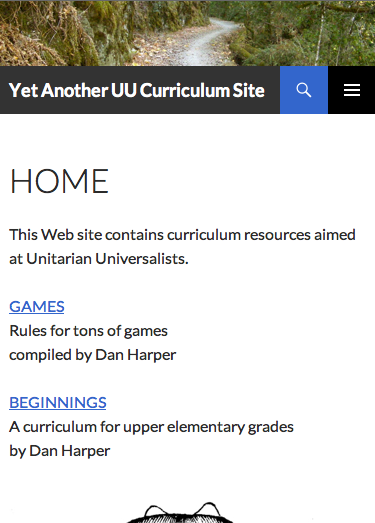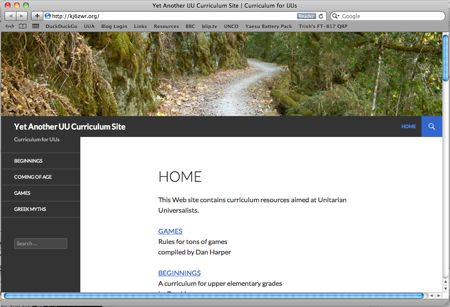Over the past few years, I’ve slowly been developing UU religious education curriculum that are meant to be published online. This past week, I finally put together a new Web site to publish them: Yet Another UU Curriculum Site.
At present, three curriculum are published on this site: “Beginnings,” an 8-session course for upper elementary grades; “Coming of Age,” a 9 month, 17 session, program for gr. 8-9; and “Greek Myths,” an 8-week course for upper elementary grades that’s still in development. In addition, I’ve included a selection of games that are appropriate for Sunday school classes and youth groups.
Why publish curriculum online?
First and foremost, I wanted to have the complete curriculum available in a format so that a teacher can access it with their smartphone or tablet.
This is good for teachers because all lesson plans and associated resources are easily accessible, and teachers don’t have to worry about leaving their curriculum book or binder at home. Long term, I will convert at least some of the curricula to epub format, and/or to printed books available as print-on-demand copies, so teachers can use whatever format they prefer.

Above: The site as it would be seen on a smartphone.
This is also good for parents, because parents can ask which lesson their child did on a given Sunday, and then look up that lesson online. Then they will can go over the material with their child if they want to. Some of the curricula I’m developing have a story associated with each lesson, and long term I’m planning to create storybooks in both epub and affordable print-on-demand print editions.

Above: The site as it would be seen on a laptop or home computer.
Second, I wanted to have curricula online side-by-side with supporting resources. Thus, one of the first resources I’ve put up on this site are lots of games. That way, if a lesson plan fails, a teacher will have immediate access to back-up activities. Long term, I’m working on an online how-to-teach resource, with tips and techniques for adapting printed lesson plans for your own needs.
Finally, I want to see where this leads me, and I suspect I’ll start thinking differently about curriculum development. With cheap, easily accessible online publishing, it won’t just be teachers who are accessing curricula — parents and even kids will be able to do so as well. I’m going to start allowing people to add comments (which I will carefully curate), and that will enrich the curriculum. Finally, I’m contemplating adding some sort of assessment section to some of the curriculum, by developing fun ways for learners to show what they’ve learned.
This is very much a project that’s in development. I would value your thoughts and comments. To view “Yet Another UU Curriculum Site,” click here.



